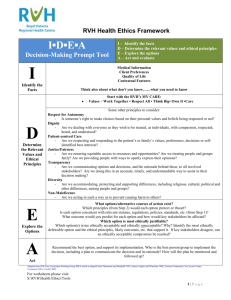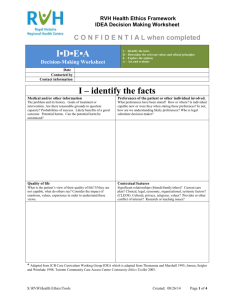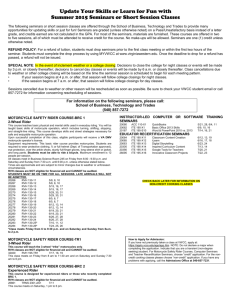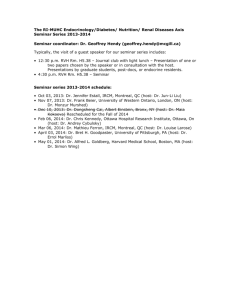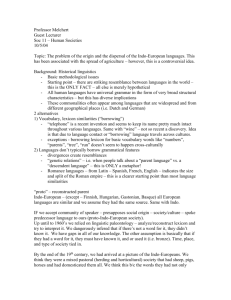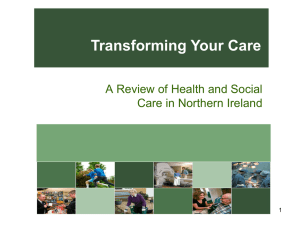Make it active when you choose a leisure activity
advertisement
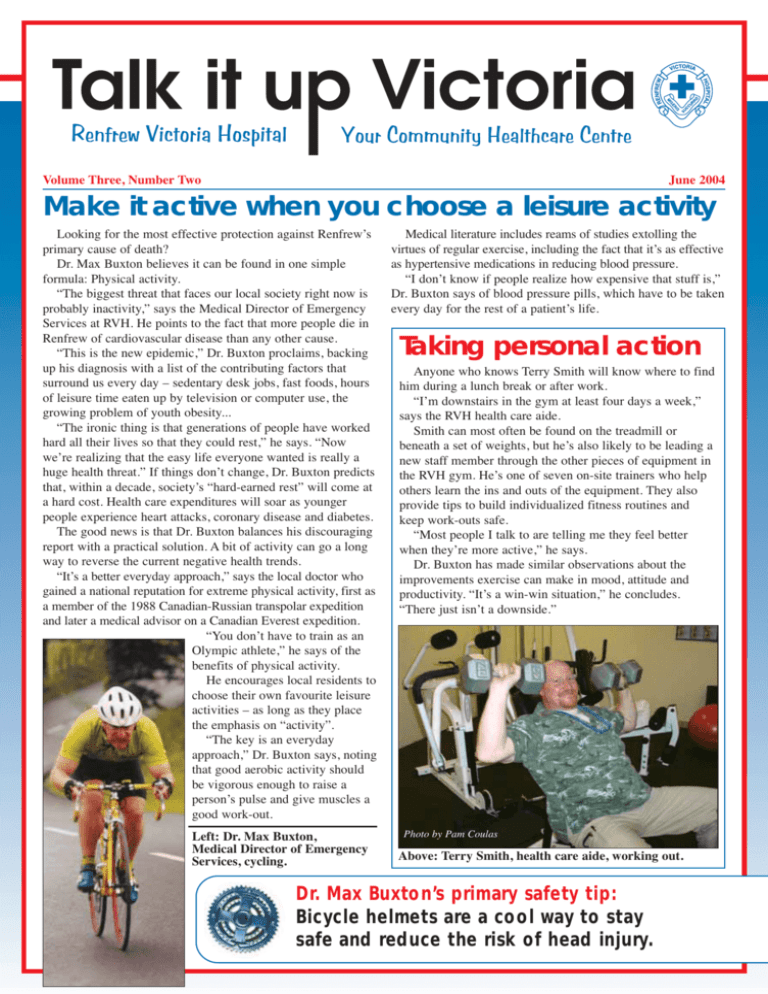
Volume Three, Number Two June 2004 Make it active when you choose a leisure activity Looking for the most effective protection against Renfrew’s primary cause of death? Dr. Max Buxton believes it can be found in one simple formula: Physical activity. “The biggest threat that faces our local society right now is probably inactivity,” says the Medical Director of Emergency Services at RVH. He points to the fact that more people die in Renfrew of cardiovascular disease than any other cause. “This is the new epidemic,” Dr. Buxton proclaims, backing up his diagnosis with a list of the contributing factors that surround us every day – sedentary desk jobs, fast foods, hours of leisure time eaten up by television or computer use, the growing problem of youth obesity... “The ironic thing is that generations of people have worked hard all their lives so that they could rest,” he says. “Now we’re realizing that the easy life everyone wanted is really a huge health threat.” If things don’t change, Dr. Buxton predicts that, within a decade, society’s “hard-earned rest” will come at a hard cost. Health care expenditures will soar as younger people experience heart attacks, coronary disease and diabetes. The good news is that Dr. Buxton balances his discouraging report with a practical solution. A bit of activity can go a long way to reverse the current negative health trends. “It’s a better everyday approach,” says the local doctor who gained a national reputation for extreme physical activity, first as a member of the 1988 Canadian-Russian transpolar expedition and later a medical advisor on a Canadian Everest expedition. “You don’t have to train as an Olympic athlete,” he says of the benefits of physical activity. He encourages local residents to choose their own favourite leisure activities – as long as they place the emphasis on “activity”. “The key is an everyday approach,” Dr. Buxton says, noting that good aerobic activity should be vigorous enough to raise a person’s pulse and give muscles a good work-out. Left: Dr. Max Buxton, Medical Director of Emergency Services, cycling. Medical literature includes reams of studies extolling the virtues of regular exercise, including the fact that it’s as effective as hypertensive medications in reducing blood pressure. “I don’t know if people realize how expensive that stuff is,” Dr. Buxton says of blood pressure pills, which have to be taken every day for the rest of a patient’s life. Taking personal action Anyone who knows Terry Smith will know where to find him during a lunch break or after work. “I’m downstairs in the gym at least four days a week,” says the RVH health care aide. Smith can most often be found on the treadmill or beneath a set of weights, but he’s also likely to be leading a new staff member through the other pieces of equipment in the RVH gym. He’s one of seven on-site trainers who help others learn the ins and outs of the equipment. They also provide tips to build individualized fitness routines and keep work-outs safe. “Most people I talk to are telling me they feel better when they’re more active,” he says. Dr. Buxton has made similar observations about the improvements exercise can make in mood, attitude and productivity. “It’s a win-win situation,” he concludes. “There just isn’t a downside.” Photo by Pam Coulas Above: Terry Smith, health care aide, working out. Dr. Max Buxton’s primary safety tip: Bicycle helmets are a cool way to stay safe and reduce the risk of head injury. Weekly sessions provide solid facts on healthy eating Low carbs... low fat... high protein... grapefruit... soup... There is no shortage of ideas about how to lose weight. But which options are healthy? What is effective? Where do you begin? Local residents gather at RVH each Wednesday afternoon to learn about healthy eating from dietary professionals. The sessions cover everything from responsible weight loss to learning how to interpret those complicated test results on triglyceride and cholesterol levels. The most popular part of the sessions is probably the time focused on practical tips for grocery shopping and food preparation. “I try to get them to look at their whole diet,” says Donna Reid, dietitian. The courses have been offered at the hospital for at least the past 10 years. Topics of interest change as trends and fads emerge, and the latest hot topic is carbohydrates. “There’s almost always a question on the low-carb diets,” notes Reid. Her analysis? “You will lose weight, but it’s not something you can maintain over the long run. You haven’t learned how to eat properly over the long haul.” By the same token, Reid will tell you that a simple switch to all low-fat foods is not a magical solution. “People will proudly tell me that they buy nothing but lowfat cookies and fat-free crackers,” she says. “They’re still eating cookies and crackers and they’re probably still eating too many empty calories.” The answer is balance – a diet that includes plenty of fruit and vegetables and the right amount of protein, carbohydrates and fat. It’s simple and it’s based on common sense, but it is still an area of everyday life where many people require support and advice. More than 1,000 people have taken the RVH healthy eating class over the past 10 years. Participants do not need a doctor’s referral to attend, but anyone interested is asked to contact Donna Reid ahead of time to confirm that space is available. She can be reached at 432-4851, ext. 109. Play the healthy numbers game every day... Make sure your daily diet includes: • at least 2 servings of fruit and 3 servings of vegetables • 2 servings of lower-fat dairy products • 5 to 7 ounces of meat or meat alternatives; make it fish at least 2 times a week • SUBTRACT sweets, starch-based snack foods and fried foods • ADD moderate exercise to your daily routine Above: Donna Reid, dietitian, with John Wilson, a graduate of the healthy eating class. This loss makes everyone a winner The equivalent of one average-sized man has disappeared from Renfrew Victoria Hospital staff over the past two years, and everyone involved is quite proud of the fact. The loss was in the form of disappearing pounds through a series of workplace weight reduction programs. Jan Leitch, administrative assistant in the hospital foundation office, has led the way, losing a total of 70 pounds. “She’s the best success in my 20-year career,” says Pam Cranfield, director of dietetics and coordinator of the weight loss programs at RVH. Leitch began her campaign in January 2003 after a bout with kidney stones. “I realized that you should take advantage of your health and mobility when you can,” she says. She adds that it has been a full-time commitment ever since. “It’s tough,” she admits. “You really have to psyche yourself.” Leitch combines a careful diet with plenty of activity. She wears a pedometer faithfully and, at the peak of her weightloss efforts, she regularly clocked 30,000 steps each day. “I’ve almost ruined my rug,” she laughs, explaining that she gets up and walks during every television commercial as part of her commitment to keep active. While Cranfield calls Leitch her “star pupil”, she is just as enthusiastic about the 45 other hospital employees who have participated in her programs. “It’s a real accomplishment,” she says. “Even if they didn’t all lose a lot of weight, we have to remember that they also might have gained over that time period.” Cranfield enjoys developing creative strategies to help hospital staff become more conscious of their eating habits. Special promotions are regularly offered in the RVH cafeteria, and suppliers often donate prizes for contests. “We always offer healthy options, and we try to make them as appealing as possible,” she notes. Healthy work habits include proper positioning Remember when Mom used to hound you to sit up straight and watch your posture? She had a good point, says Sean Corrigan, a physiotherapist at Renfrew Victoria Hospital. Since last September, he has performed ergonomic assessments on work areas throughout the hospital. Corrigan looks at computer stations, work habits, repetitive tasks and equipment to help hospital staff avoid sore backs, aching muscles and unnecessary discomfort. “Even a small change can make a big difference,” he says, noting that chair height and computer monitor placement are two of the most common adaptations he recommends. Corrigan, who has a university degree in kinesiology and physiotherapy, has been a valuable resource during the hospital’s recent renovations, helping to plan ahead to make new work areas as comfortable and efficient as possible. He has provided criteria that will be used for equipment purchases now and in the future. “It’s something I find interesting,” he says. Corrigan’s next project is to develop a back care presentation, which he will modify for various departments in the hospital. “The needs are different for people on our maintenance staff than they are for people in our administrative offices,” he says, noting that the presentation will provide back protection and care tips that staff can apply at work and at home. He hopes to also be able to share those messages with the public once the presentations are prepared. In the meantime, here are Corrigan’s top tips for a user-friendly workstation: • adjust your chair height so that your knees bend 90˚ with your feet resting flat on the floor • there should be a space the width of your fist between the back of your knee and the chair seat • your keyboard should be at the same height or slightly higher than your armrests • your computer monitor should be about an arm’s length away, and the top of the screen should be at eye level • take a break every 20 to 30 minutes to move about and stretch. “You have to consciously always tell yourself to do these things,” says Corrigan. “It takes a bit of effort, but it’s worth it.” Tackling addiction with a positive approach Ron Parker wants to dispel the myth that people who visit the Renfrew County Alcohol, Drug and Gambling Assessment Referral Service will receive harsh lectures about the evils of alcohol or be expected to quit a habit cold-turkey. “We work from a philosophy that our work is motivational,” says the director of the county-wide service, which is sponsored by Renfrew Victoria Hospital. “We’re trying to awaken the individual to their own potential,” he explains. “It’s us working with them to become aware of their skills and abilities.” That means the six therapists who offer the service do not see themselves as disciplinarians or “behaviour police”. Instead, they are active listeners who help clients tackle and cope with addictions that are affecting their lives and families. In terms of drinking, the service promotes low-risk, low-harm use of alcohol based on standards established by the Centre for Addiction and Mental Health. While the guidelines vary according to body weight, gender and other factors, the bottom line is a recommendation of no more than 12 standard drinks a week and avoiding drinking two days in a row. “If you really want to reduce your risks of harm, don’t drink,” Parker notes, adding that such abstinence is not necessary for most people who can drink in moderation. If someone is worried about becoming dependent on alcohol, referral service therapists can offer a variety of interventions, including teaching clients alternative relaxation techniques. “We try to keep our work very simple,” Parker explains. “We look for the strengths and how those strengths can be applied to problemsolving and problem resolution.” Alcohol is only one addiction the service attempts to tackle. Drugs and gambling are other issues faced by Assessment Referral Service clients. Counsellors help individuals who want to conquer their own challenges, and they also provide support to family members who are struggling with addictive behaviour in someone they love. “We can help them build more effective strategies to deal with their own reactions such as internalized guilt and shame,” Parker explains. The service provides a variety of avenues for support. In Pembroke, a clinical group has been established for people who have had residential therapy in the previous year. At Opeongo High School, a clinical treatment group is geared to reducing harm for students who have been identified by school staff as being at high risk for addictive behaviour. Last year alone, the service provided support to more than 400 clients and their spouses or family members. If you are concerned about addiction in your family, please contact the Renfrew County Alcohol, Drug and Gambling Assessment Referral Service at 613-432-9855 or 1-800-265-0197. Pamphlets and other information material can be picked up at the Renfrew office at 210 Lochiel Street. Offices are also located in Pembroke, Arnprior and Eganville. Celebrating achievements is an important part of healthy living Employees at RVH are invited to honour their peers by nominating them for “3D” awards in recognition of their dedication, determination and desire. Here are the most recent 3D recipients, with a few of their nominators’ comments: Dr. Bruce Strader (photo at right) - His compassion for the patients, especially in geriatrics, goes far beyond expectations, giving them respect, dignity and time. Every year from its start, Dr. Strader has faithfully donated his time to the Teddy Bear Bash Unit for RVH. His care and devotion are obvious as he tends to a child’s broken treasure. Teresa Connaughan & Bonnie Nolan (photo below left) - For a combined total of 48 years, Bonnie and Teresa have quietly gone above and beyond their normal job responsibilities as RPNs in the dialysis unit at RVH. Whether it is providing homemade treats for dialysis patients and staff; preparing and inviting patients and staff to their annual “Octoberfest” feast; cooking a meal for 300 people in the community; maneuvering a team of horses on a hayride for seniors and children; working in the sugar bush to produce decadent maple syrup for the enjoyment of others; or participating at the union executive to promote morale, harmony and professionalism, Bonnie and Teresa offer encouragement (as well as nourishment) and inspire others. They have big smiles and big hearts, and we thank them for their kind, caring and thoughtful efforts to enrich the lives of others. In Memory of Paul Doyle Try the ultimate air freshener Spring is in the air – can you enjoy the experience? Why not make this the year that you throw away those cigarettes for good? Staff at RVH see the negative effects of smoking every day – emphysema, lung cancer, heart disease and strokes. “None of them are choices any of us would voluntarily make,” comments RVH Director of Respiratory Therapy Maureen Magill. RVH went completely smoke-free when it closed the patient smoking lounge in January. Patients who are addicted to tobacco are now offered a nicotine patch when they are admitted to the hospital. “We all know we shouldn’t smoke,” says Magill, noting that she is encouraged by the increasing number of municipalities that are banning smoking. RVH encourages smokers in the Renfrew area to think about the costs that come with their habit, in terms of money, health and quality of life. Please make the commitment to stop – and really smell the roses this summer! This issue of Talk It Up Victoria is dedicated to the memory of Paul Doyle, reeve of Greater Madawaska Township and a former member of the RVH board of trustees. Reeve Doyle passed away at the age of 72 in April. He was known throughout the county as a strong-willed man who took firm stands on a variety of issues. Reeve Doyle was on the RVH board from May 1992 until September 2000. He served on the bylaws and nomination committees. “He was an effective advocate on behalf of our patients from his area,” commented RVH CEO Randy Penney. “He was an independent thinker and an active voice at our board table.” Fellow RVH Trustee Gerry Richards also paid tribute to Reeve Doyle. “There are not too many characters left who do good and raise you to a higher level,” Richards commented at the April hospital board meeting. “He was very helpful and extremely supportive of the hospital,” he concluded. Talk it up Victoria - the Renfrew Victoria Hospital newsletter Renfrew Victoria Hospital, 499 Raglan St. North, Renfrew, Ontario K7V 1P6 • www.renfrewhosp.com CARING for TOMORROW News from the Renfrew Victoria Hospital Foundation If you would like to learn more about the various ways you can contribute to Renfrew Victoria Hospital, please contact us: Renfrew Victoria Hospital Foundation, 499 Raglan Street North, Renfrew, Ontario K7V 1P6 Phone: (613) 432-4851, ext. 263 Honouring the difference volunteers make The Trinity-St. Andrews United Church hall was filled to capacity with volunteers, and people who wanted them to know they are appreciated, at the annual RVH volunteer appreciation luncheon in April. More than 250 people give their time to contribute to the hospital on a regular basis. They can be found in virtually every department, quietly contributing to the care that is provided. “RVH is blessed with the skills and dedication of many volunteers who offer their assistance in so many ways,” commented CEO Randy Penney. The list of volunteer activities at the hospital is endless – they support the clinics, deliver meals in the community, supply and manage the gift shop, provide palliative care, entertain patients, serve on the board of trustees and the foundation, and organize fund-raising events. “They give the best things they have,” said Penney. “Their time, their talents and their commitment.” Those who attended the luncheon were presented with a certificate of appreciation and a carnation. Barbara Symington, director of the RVH Foundation, received a special surprise tribute for her own 36 years of volunteering. She also spoke in praise of the many people who contribute to RVH. “While we choose National Volunteer Week to honour you, we sincerely appreciate you all year round,” she noted. “You work tirelessly, and on behalf of our patients and our RVH family, we can’t thank you enough.” From left, Gerry Letang and Fran Campbell were two of the volunteers who enjoyed lunch at Trinity-St. Andrews. Staff members Connie Legg and Roxanne Nolan made the presentations. A table of volunteers smiles for the camera. Planning ahead... Caring for Tomorrow Consider yourself invited... The coming months are going to be an exciting time for RVH! Please join us at any or all of the following events: l June 4, 2:00 p.m. – unveiling of our new donor recognition wall in the main hospital corridor l June 9 - Briscoe’s LOEB Charity Golf Tournament, Renfrew Golf Club l June 11 – RVH Golf Tournament, Renfrew Golf Club l June 19 – Teddy Bear’s Picnic l June 24 – RVH Annual Board of Trustees Meeting, with guest speakers Ottawa Hospital CEO Jack Kitts and Peggy Taillon-Wasmund, a leader in infection control policy development since last year’s SARS outbreak l July 9-11 – The Valley Bluegrass Festival l July 30 – The Cobden Civitan Golf Tournament at the Oaks of Cobden We couldn’t do it without you! The support RVH receives from the Renfrew and area community is absolutely unbelievable. Since our last issue of Talk It Up Victoria, we’ve received substantial contributions from the following people and organizations: - the Renfrew Rotary Club - the Denbigh Lions Club - Sport Renfrew - Ronald Newberry contributed to the Palliative Care Education Fund - Ben Hokum & Sons Ltd., M.W. Miller Logging and Summers Logging and Tree Service - Fraser’s Clothing hosted the “Spring Has Sprung” fashion show - the RVH Auxiliary made a contribution to the Equip for Care campaign at its annual meeting in April - a bequest was received from the estate of Dorian Dickson Bachert - The Puhalski Family Scholarship fund made a donation for obstetrical equipment - Katy Akse, seen below with Barb Symington, donated a quilt which is currently being raffled Thank you so much for all of your support. It makes the world of difference! RVH’s golf committee, from left: Kris Costello, Jim Lemenchick, Norm Dagg, Phil Windle, Bill Rainboth, Kathy Dagg, Brent Carson, and Barb Desilets. Missing from the photo are Lesley Murray, Barb Symington, Harvey Murray – A foundation profile “Our baby is coming to life.” The enthusiasm in Harvey Murray’s voice cannot be missed. As a member of the RVH Foundation board, he has been involved with months of planning for the new donor recognition wall. As he spoke, the panels were being installed to recognize people and organizations who have contributed $1,000 or more to the hospital. “It’s been a very exciting project,” Murray says. The committee visited a number of hospitals to gather ideas, and has been active in helping to design the new display panels. “Just the fact that we ran out of space on the old donor wall tells the story,” Murray adds. “This is an excellent organization to be involved with.” Murray spent most of his life in Montreal where he was vice-president of marketing for Pratt and Whitney. He lived in Renfrew from 1973 to 1986 when he worked at the local Haley Industries plant, and he chose to return to the Ottawa Valley when he retired in March 2000. On the invitation of Jim Lemenchick, Murray led one of the Equip for Care fundraising teams when that campaign began in the spring of 2001, and he found the experience to be both enjoyable and meaningful. “It was a tremendous way to meet people who had similar ideas,” he says. His own care at the hospital following a heart attack, combined with that Equip for Care experience, inspired him to become a member of the Foundation board. “There were a number of things that said this is what I should be doing,” he says.
